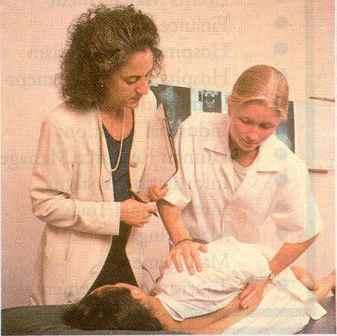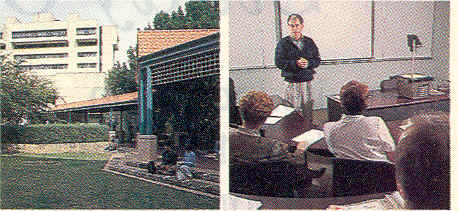Chiropractic Studies in AustraliaChiropractic Study Opportunities Kristina Sinclair Curtain University
Chiropractic is the art, science and philosophy which recognises the importance of the relationship between the musculoskeletal structures and the nervous system in health, and which by spinal adjustment, manipulation or other physical means, fosters the integrity of this relationship and uses the inherent recuperative powers of the body in the restoration and maintenance of health. Chiropractic places emphasis on maintaining the structural integrity of the body, in particular the spine. Chiropractors believe any alteration to normal spine function and mobility affects the transmission of nerve impulses along the spinal cord and spinal nerves, in turn affecting the parts of the body served by the nerves. If the disturbed nerves serve one of the internal organs, that organ could develop a disorder. If the disturbed nerves serve muscles and soft tissues, pain could result. To correct spinal problems, chiropractors perform a gentle and specific form of manipulation known as an 'adjustment'. This is usually done by hand or with the aid of a special instrument. The purpose of an adjustment is to relieve pressure on sensitive nerves and correct abnormal structural relationships, allowing healing to occur and pain to subside. Chiropractors rely on their special knowledge of anatomy as well as manual skill and dexterity to assess joint movement and detect increases in muscle tone and other tissues around joints. In most cases (especially with long-term problems), x-rays are used to reveal pathological spinal changes not always evident from physical examination. X-rays provide the chiropractor with extra information, aiding in the selection of the best treatment. Chiropractic treatment is based on the principal that mechanical dysfunction is best corrected by mechanical means. The main dysfunction a chiropractor treats is known as the "subluxation". The spinal subluxation is a general term used to describe a mechanical disorder of a joint within its normal range of motion and can apply to movement or position. Subluxations are corrected by chiropractic adjustment. Chiropractic adjustment aims to restore the normal functions to the joints being adjusted. Adjustments correct any misalignments of the bones and correct mobility - or lack of it - between the joint surfaces. If abnormal joint function continues without correction, it can eventually pro- duce permanent structural damage. This permanent damage can lead to a chronic problem in the future. Different adjustment techniques are used for different areas of the spine and techniques are varied to suit the individual patient's problem. Students looking to study for a degree in Chiropractic may begin by covering basic areas such as Chemistry, Biology and Physics before moving on to Biochemistry, Molecular Biology, Animal Structure, Human Anatomy and Histology. The final year of a BSc Degree course would also probably focus on Hormones, Nerves, Muscle and Cardiovascular Physiology, Visceral Physiology and Neuroscience as a final grounding in the introduction aspects of Chiropractic. Postgraduate studies in Chiropractic some times require students to have covered areas such as psychology, pharmacology, microbiology and immunology, they are then permitted to more in-depth study into the diagnosis of the spine, limbs an joints. Another area that students may continue into, having gained a degree in Chiropractic is sport science. To continue studying at post-graduate level in this area, students must usually be in possession of a recognised chiropractic qualification and are normally required to have a current licence to practice chiropractic in Australia. Postgraduate studies in sport science cover topics such as Exercise Physiology, Athlete Training Methodology, Strapping and Bracing Techniques, General Injuries, Prescribed and Prohibited Substances in Sport and Sports Trainer courses. Studying Chiropractic at an Australian University gives you the opportunity to cover a vast spectrum of science areas resulting in the achievement of a widely recognised professional qualification, the ideal basis for a successful career.- planned career direction and is in line with what the global business world now wants - relevant courses on demand as part of a process of lifelong learning. Business course specialisations now available in Australia cover a wide spectrum, from the management of finance, sports, local government and hotels, to tourism, marketing, public relations and personnel management. Demand for Business Training Tourism is a particular growth area in terms of business course specialisations. Within a decade, Australia is expected to annually host more than 3.5 million overseas visitors, each staying an average of 24 nights. The challenge will be to ensure the proper infrastructure, professionally qualified management and trained staff to deal with this growth. Another area facing increasing demand is marketing. Despite the relatively high cost of such degrees, the demand for postgraduate marketing degrees has ballooned in Australia over the past five years. Most of the students enrolling in these second degree courses are sponsored by their employer, a factor in the growing importance of links between business schools, the professions and industry. Australian business schools have offered commerce degrees for more than 40 years, usually based on the quantitative academic disciplines. Some business schools, such as Curtin, have expanded this to cover a much wider range of specialisations with more practical content about the way the world of business works. Globalisation of Business Education Business education is on the crest of a new wave. The rapid globalisation of business on the threshold of the new millennium demands that executives continually upgrade their professional development with a focus on strategic planning, competitiveness and professionalism. Australia is likely to develop several major regional universities with more than 100,000 students, drawing student cohorts from many APEC countries, in widely dispersed branch campuses, linked by information and communications technology. This current IT revolution in global business is bringing new opportunities and challenges for all business professionals. One likely outcome is that Autralian businesss choois will be prompted to become part of global campuses, using the Internet and product 'branding' to become linked to such prestigious centres as Harvard and INSEAD, instead of competing against them. This trend to intemationalisation will mean some significant changes in approaches to courses and programs. One of the primary goals of such regional business schools will be to successfully prepare people for entrepreneurial and management careers on a regional basis. This has implications for the knowledge, competencies and contacts which students will need to acquire during their courses. It also raises the question of the role and status of written and spoken English. Australia's regional universities will need to give greater prominence to languages such as Mandarin.
|
|
| ||||||||||||||||||

 Since its inception more than 100 years ago, chiropractic has become the largest drug-free healing profession in the Western world. Barry Dentice at Macquire University explains the theory behind the practice...
Since its inception more than 100 years ago, chiropractic has become the largest drug-free healing profession in the Western world. Barry Dentice at Macquire University explains the theory behind the practice...
